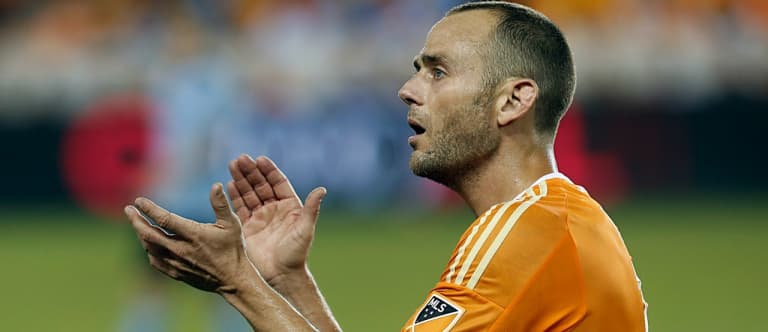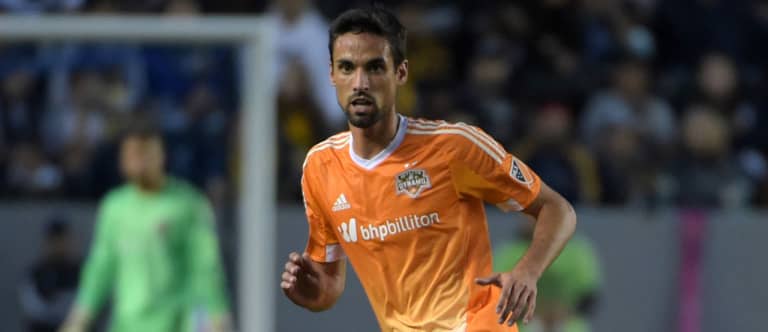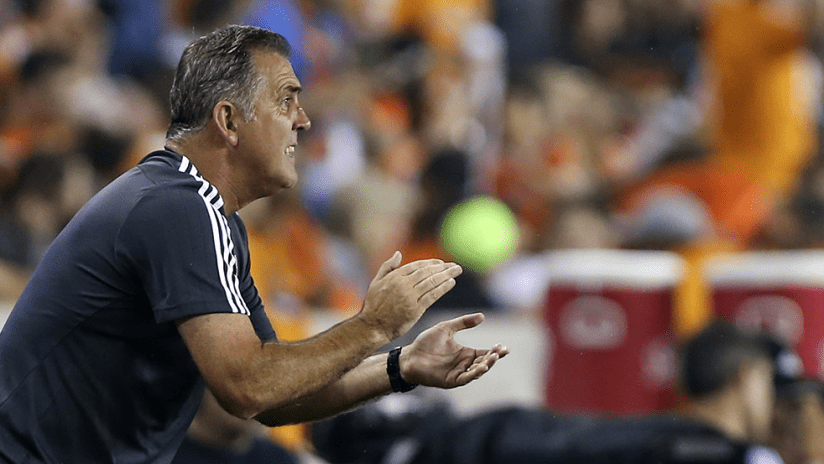HOUSTON – “Si, si!” bellows Giles Barnes, calling for a pass from Cristian Maidana as Alex makes himself available and Owen Coyle looks on. A Londoner speaking Spanish to an Argentinian as a Brazilian midfielder makes a run and a Scottish coach barks instructions from the sideline. Welcome to the new Houston Dynamo. And for that matter, welcome to Houston.
Every offseason is a time for reinvention, but the renewal process was especially profound in southeast Texas over the winter as the club said goodbye to captain and Dynamo original Brad Davis, a new majority owner took charge and Coyle continued to reshape the roster he inherited from former head coach Dominic Kinnear.
Of 10 offseason signings, only five were born in the States. Of the 28 men likely to make the roster for the start of the season, 16 are US-born. The rest hail from Brazil, England, Spain (x3), Honduras, Argentina (x2), Colombia, The Gambia, Nigeria (x2) and Mexico. About a dozen of the players speak Spanish fluently. And others, like Barnes, are trying.
“The changing room is pretty funny because it flip-flops between Spanish and English all the time. We’ve had a lot of Spanish-speaking players over time, obviously a lot of people in Houston speak Spanish, so you have to try and grasp that lingo,” said Barnes after a 5-0 scrimmage win over Houston Baptist University earlier this month.
“I can have the occasional joke in Spanish. It’s interesting because you’re always learning. They’re learning English, we’re learning Spanish – it’s pretty fun.”
It’s a contrast from 2014, the last year of Kinnear’s long reign, when the foreign contingent consisted of three Jamaicans, three Hondurans and two Britons. And the increasingly cosmopolitan look of the roster is not by chance as the Dynamo look to redefine their identity and return to the playoffs in the new, globalized MLS, where about half the players are foreign.
“You want to win soccer games with whoever it takes, wherever they’re from. But ideally you want to represent your fan-base while you’re winning soccer games. So there is an objective there to have a team that represents this city,” says Dynamo president Chris Canetti.
Matt Jordan, the vice president/general manager, puts it neatly: “The team is a reflection of the city, and the city is a melting pot.”
He’s right – Texas cowboy clichés don’t exactly fit in Houston. A 2012 Rice University study named the city as the most ethnically diverse large metropolitan area in the nation. The country’s fourth-largest city is about 44 percent Hispanic, according to census figures. Yet until now, the Dynamo roster didn’t fully reflect those demographics. Instead, it emulated the city’s traditional image: Blue-collar, hard-working, unpretentious, pragmatic, more scrappy than stylish.
Those traits were implied by the franchise’s name – evoking industrial energy and the great workers’ clubs of Eastern Europe – and impelled by the tactical style and personality of Kinnear, who was the only head coach in the Dynamo’s history from their first season in 2006 until he left for the San Jose Earthquakes at the end of 2014.
And with two MLS Cups (2006, 2007), two losing MLS Cup appearances (2011, 2012) and only two seasons under Kinnear without a postseason berth (2010, 2014), the formula worked perfectly as a gritty, stable, American core of Dynamo players – think Brian Ching, Davis and Ricardo Clark – spurred low-budget sides to high achievements.

Kinnear and the Houston front office understood that as MLS grew and aimed to compete with leading world leagues, rosters would become increasingly international. The Dynamo’s Texas location and Houston’s big Hispanic population made the club well placed to attract Latin American talent that could add flair to a team mainly known for its direct, relentless style. In 2012 the Dynamo signed Boniek Garcia, then his fellow Honduran attacking midfielder, Alex Lopez, the following year.
If the style of play evolved to become more enterprising, something was lost in translation. The Dynamo looked less solid, less intimidating and easier to beat, especially at home. On the field the team no longer seemed to have a clear identity or direction.
At the end of 2014, Canetti brought in Coyle, who earned a reputation with Bolton and Burnley in the English Premier League for overachieving on a tight budget while also producing attractive attacking soccer and developing youngsters. And Jordan, formerly with the Montreal Impact, arrived to navigate the complexities of MLS roster construction and expand the club’s scouting horizons.
The Dynamo made a substantial investment by signing Mexico international striker Erick “Cubo" Torres as a Designated Player last winter. But, shifted to the tougher Western Conference, the club again missed the playoffs in 2015. “It’s safe to say that it was a transitional season,” says Canetti.
Then, in December, minority owner Gabriel Brener, a Mexican businessman, bought out AEG’s 50-percent share in the Dynamo to assume the controlling interest. He has committed to growing the Mexican-American fan-base and continuing the club’s international outreach, both in terms of shaping the roster and wooing fans to BBVA Compass Stadium.
“Clearly, there’s that connection, and it’s something we’ll work on. But at the same time we will not ignore the other communities in the city of Houston,” Brener told MLSsoccer.com in December. “In my opinion, we are all immigrants in this country; it’s a great country, and we do not want to insult anybody. Houston, from what I understand, is more diverse in its minority component than even New York City. So I think we have to face the reality and go forward that way.”
Perhaps most significant and emblematic of the shift is Maidana. The 29-year-old midfielder was acquired along with Andrew Wenger in a December trade with the Philadelphia Union, paving the way for Houston to send the 34-year-old Davis – the club’s all-time leader in games, starts and assists – to Sporting Kansas City, nearer his suburban St. Louis hometown.
“It is a bit different obviously with Brad gone; he’s done great things throughout his career and had great contributions to this club, and he’s been here since the start. Every era comes to an end,” says Clark, now the sole remaining Dynamo who was part of those title runs in 2006 and 2007.
Canetti believes it is time to put Davis in the rearview mirror and that offseason goals have been achieved. The roster is now faster, younger, deeper and more technical than before.
“I think the club’s completely looking forward,” he said. “Everybody respects the contributions that he made to the team over the first decade, but this is about this group right now and the group is coming together. There’s a tight-knit family environment that Owen’s created, competition for lots of spots, positive things going on the field.”
Last year, defender Raul Rodriguez joined from Espanyol. For 2016, the roster features two more Spaniards, defender Agus and midfielder David Rocha.

“I knew at the beginning that some teams had more Latin players, but it was quite a surprise for example to have these two Spanish guys here. For me it was something that I never thought about, that possibility,” Rodriguez says. “It’s good that you can bring guys from Europe, from Africa; for the league it’s a good thing because you’re mixing all the styles.”
It’s good for boosting the appeal of MLS too, he feels.
Espanyol, Barcelona’s “other” club, was founded in 1900. History and tradition means that soccer culture in Spain is so entrenched, he argues, that clubs there don’t have to work as hard as MLS teams to entice fans because loyalty is passed from generation to generation, like a family heirloom. That makes community engagement especially important in MLS – whether that comes from building a winning team, playing attractive soccer or signing players who supporters can identify with.
“In Spain if my father is for that team it’s probably because his father was for that team. We follow the same team as our family,” says Rodriguez. “If you’re an older person, you’re not going to say ‘I follow Houston Dynamo because I have to because that’s the team of my family.’ It’s something that you’re choosing, and that’s a good thing, it’s a conscious decision that you’re making.
“It’s something that teams in Europe don’t have to do because they’ve been doing it for a hundred years. Here, clubs that are 11 years or 15 years old have to work, but that’s a good thing. That keeps us working in terms of the community. You’re trying to make the people from the city say, ‘Hey, that team looks a little bit like us. I can identify with that player because he’s from the same country, or I can identify with the way that player plays because that’s what I saw around me when I was young.’”
So as the Dynamo’s second decade continues, what will the club stand for? Young, hungry, quick and diverse, if Coyle has his way – and improving fast, like the league in general.
“You want Houston Dynamo to have that branding, for people to say that’s what we want to look for in the club. It’s like a baby, isn’t it, compared to the teams I’ve been in, 130, 140 years old. But the game’s growing at such pace,” he said.
With Coyle’s transition year over, everyone at the club knows it’s time to put the theory into practice, starting with the first match of the season, at home to the New England Revolution.
“Sunday, March 6th, you’ll be seeing a new-look Dynamo,” says Barnes.














